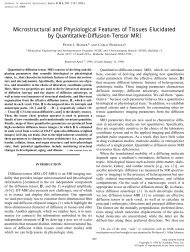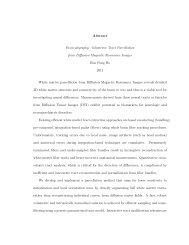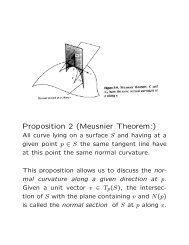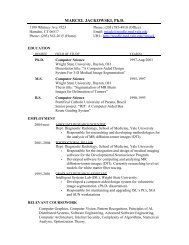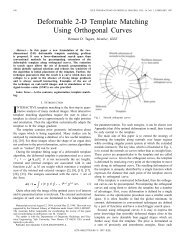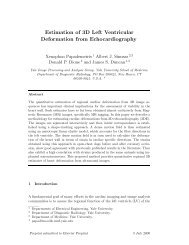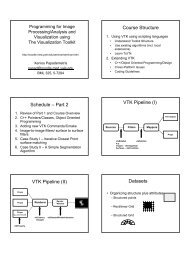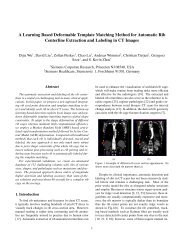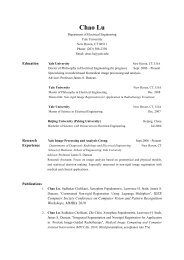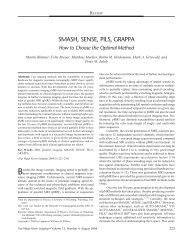Pulsed-field gradient nuclear magnetic resonance as a tool for ...
Pulsed-field gradient nuclear magnetic resonance as a tool for ...
Pulsed-field gradient nuclear magnetic resonance as a tool for ...
Create successful ePaper yourself
Turn your PDF publications into a flip-book with our unique Google optimized e-Paper software.
312<br />
PRICE<br />
complicated; also the obstructing particles are not<br />
Ž necessarily. distributed in space in a totally ordered<br />
or totally random way.<br />
CORRELATING SIGNAL ATTENUATION<br />
WITH DIFFUSION<br />
Introduction<br />
We will now discuss the mathematical <strong>for</strong>mulations<br />
necessary to relate the signal attenuation to<br />
the diffusion coefficient and boundary conditions<br />
in the PFG experiment. Starting from the Bloch<br />
equations modified to include the diffusion of<br />
magnetization Ž 75, 76. it is possible to derive the<br />
necessary relationships analytically <strong>for</strong> free diffusion,<br />
<strong>as</strong> we shall show below. However, in the<br />
c<strong>as</strong>e of restricted diffusion this macroscopic<br />
approachbecomes mathematically intractable.<br />
Thus, in general c<strong>as</strong>e one is <strong>for</strong>ced to use different<br />
approximations to find <strong>for</strong>mulae relating E to<br />
the diffusion coefficient, boundary, and experimental<br />
conditions. There are two common approximations,<br />
namely: the GPD approximation<br />
and the SGP approximation. However, even using<br />
these approximations, analytic solutions are generally<br />
not possible and numerical methods must<br />
be used. In this section, we will only consider the<br />
c<strong>as</strong>e of free diffusion and describe the macroscopic<br />
approach and the SGP and GPD approximations<br />
in this c<strong>as</strong>e. It is <strong>as</strong>sumed that the <strong>gradient</strong><br />
pulses are rectangular. Detailed discussion of<br />
the signal attenuation of spins undergoing restricted<br />
diffusion will be deferred until later in<br />
this section.<br />
The Macroscopic Approach<br />
Bloch Equations Including the Effects of Diffusion.<br />
The Bloch equations <strong>for</strong> the macroscopic <strong>nuclear</strong><br />
magnetization, Mr,t Ž . MxMyM, z includ-<br />
ing the diffusion of magnetization, are given by<br />
Ž 75, 76 . ,<br />
Mr,t Ž .<br />
MxiMyj MBr,t Ž . <br />
t T2 Ž M M . k<br />
D M. 35<br />
T1 z 0 2 <br />
In the c<strong>as</strong>e of anisotropic diffusion, the l<strong>as</strong>t term<br />
in Eq. 35 would be replaced by DM.Ifwe<br />
now take Ž <strong>as</strong> is usually the c<strong>as</strong>e. B to be oriented<br />
0<br />
along the z-axis and that this is superposed by a<br />
<strong>gradient</strong> g vanishing at the origin which is parallel<br />
to B Ž 0 we <strong>as</strong>sume that the inhomogeneities caused<br />
by g are much smaller than B . 0 , and thus we can<br />
write<br />
B 0, B 0,<br />
x y<br />
Ž . <br />
B B gr B g xg yg z 36<br />
z 0 0 x y z<br />
<br />
If Eq. 36 is then substituted into Eq. 35 , noting<br />
that<br />
MB Ž M B MB. Ž MBM B . y<br />
y z z y x z x x z<br />
Ž . <br />
M B M B 37<br />
x y y x z<br />
and defining the Ž complex. transverse magnetization<br />
<strong>as</strong><br />
mM iM 38 x y<br />
we obtain<br />
m<br />
Ž .<br />
2<br />
i0mi gr mmT2D m.<br />
t<br />
39 The Stejskal and Tanner Pulse Sequence in the<br />
Absence of Diffusion. In the absence of diffusion<br />
Ž i.e., D 0,mrelaxes .<br />
exponentially with a time<br />
constant T 2,<br />
and thus we set<br />
i 0 tt T 2 <br />
me 40<br />
where represents the amplitude of the precessing<br />
magnetization unaffected by the effects of<br />
relaxation. If we substitute Eq. 40 into 39 ,<br />
we<br />
obtain<br />
<br />
t<br />
Ž . 2<br />
igr D . 41 <br />
In the absence of diffusion, Eq. 41 is a first-order<br />
ordinary differential equation with solution<br />
Ž . Ž . <br />
r,t Sexp ir F 42<br />
where S is a constant and<br />
t<br />
H<br />
0<br />
FŽ t. gŽ t. dt. 43 Now, if we consider the c<strong>as</strong>e of the PFG pulse<br />
sequence, then during the period from the 2<br />
pulse to the pulse, we have Ži.e., Eq. 42. Ž . Ž . <br />
r,t Sexp ir F , 44



